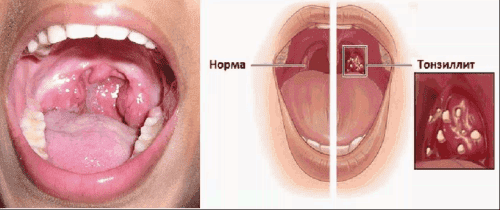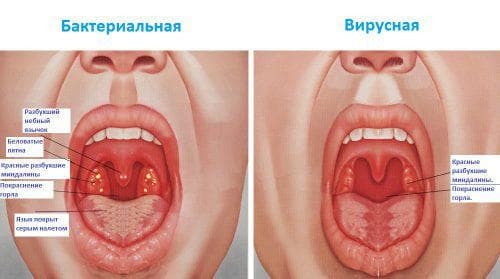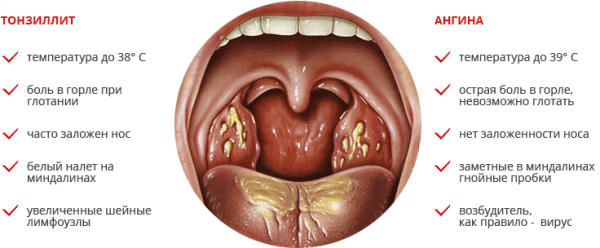
Angina and tonsillitis - these two phenomena are sometimes very confused in medical terminology. But an experienced doctor knows that there are certain differences between them, despite the fact that they are so similar. In fact, this is one and the same pathology, but only with the difference, angina is an acute form of the disease, and tonsillitis is chronic.
- 1 content
- 2 first disease manifestation Symptoms of second disease
- 3 Distinctive features of
- 4 symptoms Distinctive features in the treatment of
How the first disease manifests itself
Tonsillitis is a pathological phenomenon characterized by inflammation of the palatine tonsils. Influences on its development can be viruses and bacteria. Compared to sinusitis, the development of the disease is associated with complications that occur after a previous flu or ARI.
Factors such as prolonged exposure to cold, decrease in protective forces, stress, fatigue and poor nutrition of
can affect the appearance of chronic form. In tonsillitis, inflammation can affect one or more of the lymph nodes in the pharyngeal ring. In most cases, the lesion is applied to the tonsils.
On photo-tonsillitis
Tonsillitis can be represented in the following forms:
- Simple. It is characterized by local clinical manifestations.
- Toxico-allergic. It can cause the consequences that affect the kidneys, joints, heart and blood vessels.
If we talk about the clinical picture of chronic tonsillitis, at first glance they are very similar to the acute form of angina, but they do not have such severity.
On video signs of the disease and the course of tonsillitis:
In tonsillitis the patient may be disturbed by the following symptoms:
- sensation of foreign body in the throat;
- pain in the throat, difficult to breathe through the nose;
- is a bad flavor from the mouth;
- painful sensations when swallowing;
- tonsils increase in size and are covered with a red and purulent coating;
- general malaise.
Chronic tonsillitis is an acquired form of ailment, when patients do not seek medical help at the time.
In addition, the following factors can influence its development:
- untreated tonsillitis;
- persistent diseases of the nasopharynx;
- frequent ailments that affect the oral cavity.
Chronic tonsillitis often leads to the development of complications that are of an immune origin and have a negative effect on the work of the kidneys, heart and joints. And they arise because of incorrect or untimely treatment of an acute form of pathology.
Symptoms of the second disease
It is the acute course of the pathology that is the sore throat. It is of an infectious origin. The focus of the disease is concentrated on the palatine tonsils and is of bacterial origin. You can determine by purulent coating and the presence of vesicles.
Angina is a pathology that involves a number of serious consequences. They affect various organs of the human body. Why is it important to recognize the disease in time and start its therapy.

On the photo-angina
The following symptoms of angina are distinguished:
- body temperature rise;
- sore throat, which has a sharp and cutting character;
- painful swallowing syndrome;
- headache;
- joint pain syndrome;
- is difficult to breathe on its own;
- poor appetite;
- general malaise;
- change in the size of the lymph nodes, located in the region of the jaw and neck;
- amazed tonsils of red color with whitish bloom;
- amazed tonsils of red hue with light yellow vesicles.
The development of angina can affect such pathogens as streptococci and viruses. Factors for the development of the disease can be primary, secondary and specific.
 How is prophylaxis of angina in children, and what medicines can help with this problem, is described in this article.
How is prophylaxis of angina in children, and what medicines can help with this problem, is described in this article.
What is the causative agent of angina, and how to determine the signs that appear, will help to understand this information.
And here's how to use the Stopangin spray for children, and what effect can be expected from the application, this information will help to understand: http: //prolor.ru/g/lechenie/ stopangin-sprej-instrukciya-po-primeneniyu.html
Maybe you will also be interested in learning how to grow Chlorophylliptwith angina.
Angina is an infectious disease, therefore it has certain types, which differ according to which virus caused it. Each type of disease has its own characteristics. For example, for the catarrhal form of angina, percussion in the throat and pain associated with swallowing are characteristic, with the temperature rising to the level of 38 degrees. The consequences after such an angina are absent, and after 3-5 days she leaves on her own.
On video antibiotics for angina:
Distinctive features on the symptoms of
Since the symptoms of angina and tonsillitis have already been considered it is time to draw a conclusion to understand what these two inflammatory processes differ from each other.
Thus, we can distinguish the following differences:
- The development of tonsillitis occurs gradually. At the same time, it can stop for a while, and then resume again. Thus, two stages are distinguished: remission and exacerbation. But angina occurs due to infection in the body. In this case, the patient has a sharp rise in temperature and a sore throat, which is acute.
- For a sore throat is characteristic purulent deposit, and for a tonsillitis - caseous stoppers.
- Tonsillitis is manifested by the complexity of nasal breathing, and with angina this symptom arises extremely rarely.
On video, how to distinguish angina from tonsillitis:
Why does angina occur without the temperature and sore throat, and how to identify this disease, will help to understand this information.
And how many days to take Amoxiclav in angina, and how quickly you can achieve the desired result, is described in detail in this article.
It will also be interesting to know how effective the iodine grid is in angina.
But how to treat follicular angina at home, and whether it is possible to cure such a disease on its own, is described in great detail in this article.
How purulent angina flows without temperature, and what remedies you can get rid of this problem, this article will help to understand.
Distinctive features in the treatment of
Tonsillitis, regardless of form, requires timely and adequate therapy. It is based on antibacterial drugs, the purpose of which is to eliminate bacteria.
It is very easy to treat angina, which can not be said for tonsillitis. Chronic ailment can be treated by rinsing with solutions, the purpose of which is to disinfect the oral cavity. Physiotherapy and a course of antibiotics can also be prescribed. When the performed measures did not give the desired effect, the doctor can resort to surgical treatment, which involves the removal of tonsils.

On the photo, the difference between angina and tonsillitis
This kind of operation differs in its simplicity in terms of performance, and complications after it are absent.
Getting rid of chronic tonsillitis is much more complicated than from tonsillitis. Based on this, the main task for a patient with angina is to prevent the transition of the disease into a chronic form.
In addition, for the treatment of both forms of the disease can be used and folk remedies. With angina they help to eliminate inflammation, pathogenic microflora and alleviate the course of the disease. But with the chronic form of the disease folk remedies serve to prolong the stage of remission and not to give rise to complications, but they are not able to directly treat the disease.
Tonsillitis and tonsillitis are different forms of the same disease, which is accompanied by inflammation of the palatine tonsils. Angina is the acute course of the disease, and tonsillitis is chronic. These two phenomena differ in the symptomatology and method of therapy. In addition, tonsillitis is often the result of an untreated tonsillitis, so getting rid of it will be much more difficult.
